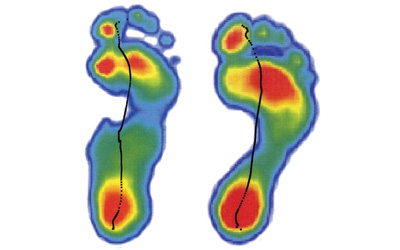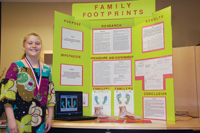
Dr. Lee Smolin is a theoretical physicist from the University of
Waterloo who recently said that we are “living in a time when the
questions are changing.”
Dr. Lee Smolin is a theoretical physicist from the University of Waterloo who recently said that we are “living in a time when the questions are changing.” The comment was made within the context of a discussion amongst physicists,1 but Dr. Smolin was referring to all scientific inquiry and to the actions it results in.

|
|
| Left: Representative footprint from Family 1, with over-pronation and poor plantar arch. Right: Representative footprint from Family 2, no over-pronation and good plantar arch. Advertisement
|
For example, the questions that frame studies in genetics with respect to chronic and/or terminal disease states might be undergoing reconfiguration. The current paradigm involves identifying genetic aberrations and tampering with DNA before problems arise, and/or applying aggressive treatment when these problems become dire. But the question may be evolving into how we might utilize our understanding in this area to create genetically congruent environmental and/or lifestyle patterns or therapies in the first place,2,3 thus, perhaps, tapering the need for aggressive treatments with their own, in turn, detrimental side-effects.
THE GENETICS OF FEET?
In Owen Sound, Ontario, a young investigator named Carina Fascinato (daughter of chiropractor Dr. Frank Fascinato) has carried out a preliminary study that may demonstrate a genetic predisposition to having over-pronation and flat feet. Over-pronation is an inward rolling in of the feet that often also involves a collapse of the arches of the feet, otherwise known as flat feet. If this particular combination develops, the individual will probably experience some degree of foot pain within their life, and possibly knee pain, achilles tendinitis, posterior tibial tendinitis, piriformis syndrome, plantar fasciitis and/or heel spurs.4
Foot problems, and the gait irregularities that might arise from them, can also be predecessors to postural abnormalities that lead to chronic pain and other issues and, as such, are within a chiropractor’s scope of concern when examining and treating patients. As a complement to adjustments, to correct foot and gait irregularities, DCs may prescribe orthotics, but the optimal plan would be to prevent these disturbances from developing at all, or to correct them in their earliest stages in hope of avoiding later problems in life – problems that might require much more aggressive therapies.
If some foot features can, indeed, be proven to be hereditary, this could guide chiropractors with respect to foot development, and possibly gait patterns, that might require early intervention with chiropractic adjustments and/or the use of orthotic inserts.
A MESSAGE IN THE SAND
Carina Fascinato, our young investigator, was at the beach one day. While walking along the shore, she was revelling in the interesting shapes that people’s feet made in the wet sand. Now, there has been much poetry and prayer, film and fancy created surrounding the romantic and spiritual notions associated with footprints on a shoreline. But Carina, being the offspring of a chiropractor, had her mind on other matters. She noticed that the shape of each person’s footprint appeared to be either somewhat flattened, due to the deep imprint of the middle section of the foot, or lacked the imprint that would be made by that middle section. Also, where there were families walking along the beach, the footprints of the children looked much like the footprints of one, or both, of their parents, especially with respect to over-pronation of their feet. Furthermore, footprints made by families looked different from those of other families. She hypothesized that the foot characteristics of over-pronation with collapsed arches could be genetic, and thus predicted within families.
Some preliminary searching through the existing literature revealed that a genetic connection had not been clearly established with over-pronation and flat feet, and thus a study to prove such a connection was launched.
THE STUDY AND FINDINGS
After visualizing footprints in wet sand, our young investigator scouted technology that would analyze footprint characteristics. She contacted some companies where this technology was available and told them about her proposed study. As the study would be original work, one company was very interested in participating, and thus agreed to assist her in carrying it out. They invited her to their facility, where they trained her to use their gait analysis instrumentation, and then loaned her a unit for her study.
 |
|
| Carina Fascinato designed an initial study to examine possible hereditary links in foot characteristics. |
Once the technology for measuring and recording footprints had been procured, two unrelated families, each composed of several generations, were invited to participate in the study. Family 1 consisted of four generations and Family 2 had three generations.
Each participant was analyzed for the footprint characteristics of over-pronation and flat feet in both feet. Measurements and calculations were carried out roughly as follows:
Using the gait analysis instrumentation, all participants were instructed to walk across a pressure-sensitive foot plate (called a pedobarograph) in order to obtain footprint scans for each foot, one foot at a time. When all pressure measurements had been collected, pressure values expressed in percentages of precalibrated normative pressures were analyzed and charted according to the instrumentation’s algorithms. Contact area data was then calculated from these images.
Dynamic footprint pressure measurements – These are defined as the percentages of pressure on the medial heel and the percentages of pressure on the medial 2.5 toes while in motion. This is considered well balanced if the value is at, or around, 50 per cent. A value of significantly more than 50 per cent represents over-pronation whereas a value of 50 per cent and under suggests no over-pronation Arch index – This is a ratio of the area of the middle third of the footprint over the area of the whole footprint and is inversely proportional to arch height.
Higher arch index values, therefore, indicate flat feet. Although various foot analysis units may include algorithms for calculating arch index, in this study, arch index was determined by printing the footprint scans on paper, cutting out the footprint and dividing it into thirds, and then weighing the middle third of the footprint and dividing this weight over the weight of the entire footprint. Since the area of the paper is directly proportional to its weight, these weight ratios could be converted into arch index values.
The following results were noted:
Over-pronation – Family 1 recorded significantly higher than 50 per cent pressure readings on the medial heel and medial 2.5 toes throughout all the generations of this family. Family 2 recorded 50 per cent or lower pressure readings on the medial heel and medial 2.5 toes, demonstrating no consistent over-pronation.
Flat feet – Family 1 demonstrated a higher arch index across the generations, which is an indicator of low arches, or flat feet. However, Family 2 demonstrated low arch index values that indicated they did not have flat feet.
The conclusion made, based on these results, was that the foot characteristics of over-pronation with flat feet may be inherited, genetic traits and, as such, could be expected in individuals whose families show this trait.
STUDY LIMITATIONS AND CHIROPRACTORS’ COMMENTS
Carina’s study may, in fact, suggest that over-pronation and flat feet are genetically inherited and that the presence of these foot characteristics in one generation could warrant close following of offspring for similar problems with their feet. However, as the study only involved two families, future hereditary studies on over-pronation and flat feet, involving more in-depth analysis, and with more families, are warranted in order to evolve the clinical relevance of these findings.
The conclusions of the study, and the notion that more work is called for, are seconded by Dr. Kim Ross, chiropractor, professor and PhD researcher at the Canadian Memorial Chiropractic College (CMCC), who reviewed Carina Fascinato’s work quite closely, noting that the results could, indeed, be significant for chiropractors.
ABOUT THE INVESTIGATOR
Theoretical physicist Dr. Smolin also pointed out that we are now asking “not how to exploit the planet for human comfort and wealth, but how we make a sustainable symbiosis with the planet.” The respectful goal of working with nature must include health strategies that allow us to fully express our genetic potential rather than trying to tamper with it at its source, or later on with aggressive intervention that is, perhaps, contrary to our well-being. Through her preliminary study, Carina Fascinato has pointed us toward the possibility that detrimental characteristics of the foot could have a genetic connection. This knowledge could indicate when monitoring of foot development and gait habits may be warranted for the purpose of intervening conservatively, if necessary, from an early stage in order to avoid chronic problems and even more potentially destructive treatments, later on. In other words, we want to help people walk in a more health-congruent fashion, to avoid extensive pain medication or surgeries – neither of which represent wellness congruent goals – later on.
The study and its findings are impressive, considering Carina is a fifth grade student and is 10 years old.
Her goal is to become a chiropractor, but, at this time, she attends Notre Dame School in Owen Sound, from where she entered her research study into the Bluewater Regional Science and Technology Fair – and won a Gold Medal. Her work also garnered her the Canadian Nuclear Society Award and the Sydenham Conservation Award.
Carina Fascinato wishes to thank The Orthotic Group of Canada and Dr. Kim Ross for their interest in her study and their support throughout the investigation.
For article with references, please visit www.cndoctor.ca. •
Print this page